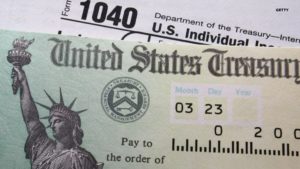
COVID-19 Stimulus Checks
The CARES Act
On March 27, the Coronavirus Aid, Relief and Economic Security (CARES) Act, a $2 trillion stimulus package aimed at assisting individuals, states and businesses affected by the coronavirus (COVID-19) pandemic, was signed into law.
The legislation will expand unemployment aid, offer billions of dollars in loans to both small and large businesses, and send $100 billion to hospitals on the front line of the pandemic.
COVID-19 Stimulus Checks
 A highly anticipated component of the CARES Act is a direct cash payment to millions of Americans. Eligible taxpayers could receive a payment of up to $1,200 for individuals, or $2,400 for married couples. Parents may also receive up to $500 for each qualifying child.
A highly anticipated component of the CARES Act is a direct cash payment to millions of Americans. Eligible taxpayers could receive a payment of up to $1,200 for individuals, or $2,400 for married couples. Parents may also receive up to $500 for each qualifying child.
For details about the arrival of the checks, what your payment could be, and whether or not you’re eligible to receive one, visit the FAQ on the IRS’s site.
FAQ for Stimulus Checks
For answers to questions about the payments, please read the following frequently asked questions:
Because direct deposit and mailed check payments are coming in waves, we’re suggesting you set up an online banking deposit alert with your bank. By doing so, you’ll be instantly notified when the money hits your account.
As of April 15, you’ll also be able to visit the IRS website to check your payment status.
Since payments are being distributed in waves, don’t be alarmed if you haven’t received yours and someone you know did. Timelines are still relatively unclear on distribution. More information can be found on the IRS’s FAQ page
If the IRS already has your bank routing and transit number because you filed your 2018 or 2019 taxes electronically, you’ll receive the funds via direct deposit. This will happen automatically, and no action is required on your part.
Direct deposit payments were sent beginning April 10 and will continue for several weeks. For members without direct deposit information on file with the IRS, payments will be issued by mail beginning in early May. You can validate the deposit date by going to irs.gov and selecting Get My Payment.
The IRS website has criteria and instructions on how to apply for a stimulus payment, as well as a link to an online form. Follow this link to get started.
Be sure to check that the IRS has your most recent information on file. Use the IRS’s Get My Payment portal to help you with this. You can use it to check your payment status, confirm your payment type (direct deposit or check), and provide bank information for direct deposit if it’s not already on file.
Protecting Yourself From Fraud
Unfortunately, fraudsters are using the pandemic as a way of taking advantage of people. The Federal Trade Commission provided 4 tips to avoid a Coronavirus stimulus payment scam:
4 tips for avoiding a Coronavirus stimulus payment scam
- Only use irs.gov/coronavirus to submit information to the IRS – and never in response to a call, text, or email.
- The IRS won’t contact you by phone, email, text message, or social media with information about your stimulus payment, or to ask you for your Social Security number, bank account, or government benefits debit card account number. Anyone who does is a scammer phishing for your information.
- You don’t have to pay to get your stimulus money.
- The IRS won’t tell you to deposit your stimulus check then send them money back because they paid you more than they owed you. That’s a fake check scam.
Per the U.S. Department of Treasury… If you receive calls, emails, or other communications claiming to be from the Treasury Department and offering COVID-19 related grants or stimulus payments in exchange for personal financial information, or an advance fee, or charge of any kind, including the purchase of gift cards, please do not respond. These are scams.
As always, please report scams to the Federal Trade Commission at ftc.gov/complaint if you think you’ve been a target of any scam or fraud attempt.




